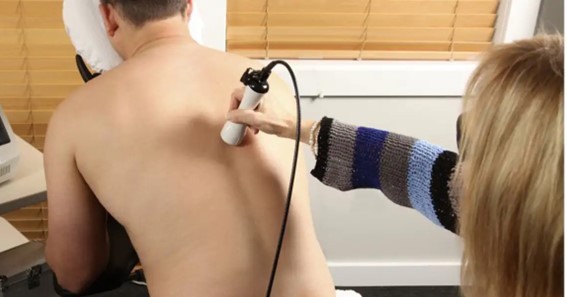Laser therapy is a non-invasive and effective treatment option for various conditions. With its growing popularity, it is essential to find a qualified and trained health practitioner that understands how to use it for the best outcomes.
Our Mechanicsburg physical therapy team uses laser techniques for a range of musculoskeletal injuries and conditions for our patients. In this way, FYZICAL Therapy and Balance Centers aims to help our patients feel their best and get back to normal life faster. Keep reading to learn more about how laser therapy works and its therapeutic applications.
What Is Laser Therapy?
Laser therapy involves the use of focused light beams with specific characteristics to stimulate cellular processes in the body. Different types of lasers, such as low-level lasers and high-power lasers, are adapted based on the desired therapeutic outcome. The concept is the interaction of the laser with the underlying tissues, triggering a cascade of physiological effects, such as alleviating pain or inflammation. Laser therapy should only be applied by a trained health practitioner, such as a physical therapist.
Laser Therapy And Physical Therapy
Physical therapy focuses on restoring mobility, function, and strength through exercise, manual techniques, and other interventions, such as laser therapy. Physical therapists often use laser therapy as a complementary treatment modality to enhance patient outcomes.
Laser therapy can augment the benefits of exercise and manual therapy. The application of laser light to specific areas of the body can help accelerate tissue repair, reduce inflammation, and alleviate pain. By promoting cellular activity and increasing blood flow to the affected area, laser therapy can enhance the effects of overall physical therapy.
How It Works
When laser light interacts with tissues, the absorption stimulates cellular activity and promotes healing. Additionally, laser therapy can modulate inflammation and stimulate the release of endogenous pain-relieving substances. These multifaceted mechanisms contribute to the therapeutic effects observed in various injuries and conditions. Physical therapists with specialized training in laser therapy can determine the most appropriate treatment plan based on the specific condition and the patient’s response to therapy.
The Elements Of Laser Therapy
The precise parameters of laser therapy, including the wavelength, power density, duration, and dosage, can be tailored to the individual needs of each patient. Optimal customization of treatment parameters is crucial to target specific conditions and individual needs. Healthcare professionals carefully assess each patient’s requirements to design personalized laser therapy plans, ensuring the best possible outcomes.
Laser Therapy Is Commonly Used For These Conditions
Laser therapy is used for various injuries and conditions, including:
- Musculoskeletal injuries: Laser therapy can be beneficial in the management of acute and chronic musculoskeletal injuries, such as sprains, strains, tendonitis, and ligament injuries. It helps reduce pain, inflammation, and swelling, while promoting tissue repair and healing.
- Sports injuries: Laser therapy is commonly employed in the treatment of sports-related injuries, including muscle strains, joint sprains, tennis elbow, golfer’s elbow, and runner’s knee. It aids in pain relief, accelerates healing, and facilitates a faster return to sport.
- Arthritis: Laser therapy can provide relief for individuals suffering from various forms of arthritis, including osteoarthritis and rheumatoid arthritis. It can help reduce pain, stiffness, and joint inflammation, improving mobility and overall quality of life.
- Back and neck pain: Laser therapy can be used to alleviate pain and discomfort associated with conditions that affect the back and neck, such as degenerative disc disease.
- Other conditions: Laser therapy continues to gain recognition and acceptance in the medical field for other health conditions, such as scar tissue, nerve damage, chronic conditions, and much more.
How Laser Therapy Can Help Rehabilitation
There are several pros and cons of laser therapy. These include:
The advantages of laser therapy
One of the significant advantages of combining laser therapy with physical therapy is the potential to reduce the reliance on pain medications. Other advantages include:
- Non-invasive treatment option
- Targeted treatment
- Enhanced tissue healing and regeneration
- Reduction in pain and inflammation
- Improved functional outcomes
- Short treatment sessions with potential for immediate relief
- Can be used in conjunction with other treatment modalities
- Minimal side effects
Disadvantages of laser therapy:
Laser therapy offers several disadvantages. These include:
- Professional supervision and expertise required for safe and effective treatment
- Cost considerations, as laser therapy sessions may be expensive
- Results may vary depending on the individual and the specific condition being treated
- Not suitable for certain individuals with specific contraindications
Precautions And Contraindications
While laser therapy is generally safe, there are certain precautions and contraindications. Contraindications may include malignancies, active infections, or photosensitivity disorders. Professional supervision ensures that laser therapy is administered appropriately and that patients receive optimal care.
Laser Therapy In Injury Rehabilitation
Laser therapy has emerged as a valuable treatment option, harnessing the power of light to stimulate healing processes in the body. Laser therapy plays an increasingly significant role in rehabilitation when applied by physical therapists for patients seeking safe and effective treatment options. Get in touch with FYZICALTherapy And Balance Centers for laser therapy in Mechanicsburg.
